Golden Fairy Cardigan |
|||||||||||||||||||
 |
 |
||||||||||||||||||
Knitted jacket in DROPS Cotton Merino or DROPS Lima. The piece is worked with round yoke and lace pattern. Sizes S - XXXL.
DROPS 195-23 |
|||||||||||||||||||
|
EXPLANATIONS FOR THE PATTERN: ------------------------------------------------------- RIDGE/GARTER STITCH (worked back and forth): 1 ridge = Knit 2 rows. PATTERN: See diagrams A.1 to A.4. Choose diagram for your size (applies to A.1 and A.4). The diagrams show all rows in the pattern seen from the right side. DECREASE/INCREASE TIP (evenly spaced): To work out how to decrease/increase evenly, count the total number of stitches on the needle (e.g. 249 stitches), minus the bands (e.g. 10 stitches) and divide the remaining stitches by the number of decreases/increases to be made (e.g. 6) = 39.8. In this example, decrease by knitting together approx. each 39th and 40th stitch. When increasing make 1 yarn over after approx. every 40th stitch; on the next row/round work the yarn overs twisted to avoid holes. Do not decrease/increase over the bands. DECREASE TIP (for sides of body): All decreases are made from the right side! Start 3 stitches before marker thread in side, knit 2 together, knit 2 (marker thread sits in between these 2 stitches), slip 1 stitch as if to knit, knit 1 and pass the slipped stitch over the knitted stitch (= 2 stitches decreased). INCREASE TIP (for mid under sleeves): Start 1 stitch before the marker thread, make 1 yarn over, knit 2 (marker thread sits between these 2 stitches), make 1 yarn over (= 2 stitches increased). On the next round knit the yarn overs twisted to avoid holes. Then work the increased stitches in stocking stitch. BUTTONHOLES (bottom up): Work buttonholes on right band. 1 BUTTONHOLE = knit second and third stitch from the edge together and make 1 yarn over. On the next row knit the yarn over to leave a hole. Work buttonholes when piece measures: S: 8, 15, 22, 29, 36, 43 and 51 cm M: 8, 15, 23, 30, 38, 45 and 53 cm L: 8, 16, 24, 32, 40, 48 and 55 cm XL: 8, 15, 22, 29, 36, 43, 50 and 57 cm XXL: 10, 17, 24, 31, 38, 45, 52 and 59 cm XXXL: 10, 17, 24, 31, 38, 45, 52 and 61 cm NOTE: The last of these 7-7-7-8-8-8 buttonholes is worked on the neck. ------------------------------------------------------- START THE PIECE HERE: ------------------------------------------------------- JACKET - SHORT OVERVIEW OF THE PIECE: The piece is worked back and forth with circular needle from mid front, bottom up as far as the armholes. The sleeves are worked in the round with double pointed needles/short circular needle bottom up. Body and sleeves are then placed on same circular needle and the yoke is finished working back and forth from mid front. BODY: Cast on 207-227-249-263-291-311 stitches (including 5 band stitches in each side towards mid front) with circular needle size 4 mm and Cotton Merino. Change to circular needle size 3.5 mm and work 2 RIDGES – read description above. Change back to circular needle size 4 mm and work 2 rows stocking stitch with 5 band stitches in garter stitch in each side. The next row is worked as follows from the right side: 5 band stitches in garter stitch, Work A.1A until there are 6 stitches left on row (= 14-18-17-21-20-25 repeats of 14-12-14-12-14-12 stitches), work A.1B (= 1 stitch) and finish with 5 band stitches in garter stitch. Continue this pattern. When A.1 has been completed, continue with stocking stitch and 5 band stitches in garter stitch in each side. AT THE SAME TIME on the first row from the right side decrease 0-0-6-0-4-0 stitches evenly on row = 207-227-243-263-287-311 stitches REMEMBER THE KNITTING TENSION! When the piece measures 8-8-8-8-10-10 cm insert 2 marker threads in the piece as follows from the right side: First marker thread is inserted after the first 54-59-63-68-74-80 stitches on the row (= right front piece when garment is worn), 2nd marker thread after the next 98-108-116-126-138-150 stitches (= back piece). There are 55-60-64-69-75-81 stitches left on row after the 2nd marker thread (= left front piece – NOTE: There is 1 more stitch on the left front piece than the right because of the pattern which will later be worked on sleeves and yoke). On the next row from the right side work BUTTONHOLE on right band – read description above. AT THE SAME TIME decrease 1 stitch on each side of both marker threads - read DECREASE TIP (= 4 stitches decreased). Continue to decrease on each side of both marker threads every 8-8-8-9-9-9 cm a total of 3 times in each side = 195-215-231-251-275-299 stitches. Continue working until the piece measures approx. 31-30-32-34-33-35 cm (measured from bottom of the curve in A.1). The next row is worked as follows from the wrong side: Work as before over the first 50-54-58-63-67-72 stitches and increase at the same time 1-6-2-6-2-6 stitches evenly over these stitches (= left front piece), cast off 4-6-6-6-10-12 stitches for armhole, work as before over the next 88-96-104-114-122-132 stitches and increase 2-12-4-12-4-12 stitches evenly over these stitches (= back piece), cast off 4-6-6-6-10-12 stitches for armhole, work the remaining 49-53-57-62-66-71 stitches as before and increase 1-6-2-6-2-6 stitches evenly over these stitches (= right front piece). There are now 50-59-59-68-68-77 stitches on the right front piece, 90-108-108-126-126-144 stitches on the back piece and 51-60-60-69-69-78 stitches on the left front piece. Lay the piece to one side and work sleeves as described below. SLEEVE: Cast on 48-52-56-56-60-60 stitches with double pointed needles size 3.5 mm and Cotton Merino. Knit 1 round. Then work rib in the round (= knit 2 / purl 2) for 3 cm. Knit 1 round where you decrease 6-8-10-10-10-8 stitches evenly on round = 42-44-46-46-50-52 stitches. Change to double pointed needles size 4 mm and work stocking stitch in the round. When the piece measures 10-8-11-11-9-9 cm insert 1 marker thread at the beginning of the round (= mid under sleeve). On the next round increase 2 stitches mid under sleeve - read INCREASE TIP. Increase like this every 2½-2½-1½-1½-1½-1½ cm a total of 13-13-19-19-19-19 times = 68-70-84-84-88-90 stitches (change to short circular needle when necessary). Continue working until the piece measures 40-38-38-38-36-36 cm (increases mid under sleeve should now be finished and measurements are shorter in larger sizes due to longer yoke). Knit 1 round where you increase 8-8-12-12-12-12 stitches evenly on round = 76-78-96-96-100-102 stitches. The next round is worked as follows: Work 2-3-3-3-5-6 stitches in stocking stitch, work A.2 over the next 72-72-90-90-90-90 stitches (= 4-4-5-5-5-5 repeats of 18 stitches) and finish with 2-3-3-3-5-6 stitches in stocking stitch. Continue this pattern until you just have the last row in A.2 left to work. The last round is worked as follows: Cast off 2-3-3-3-5-6 stitches for armhole, work last row in A.2 over the next 72-72-90-90-90-90 stitches and cast off the remaining 2-3-3-3-5-6 stitches for armhole. The sleeve measures approx. 44-42-42-42-40-40 cm from the top down. Lay the piece to one side and work the other sleeve in the same way. YOKE: Place sleeves on same circular needle size 4 mm as body, where you cast off stitches for armholes (without working the stitches) = 335-371-407-443-443-479 stitches on row. The first row is worked as follows from the right side: SIZES S, XL and XXL: 5 edge stitches in garter stitch, A.3A (= 9 stitches), work A.3B until there are 15 stitches left on row (= 17-23-23 repeats of 18 stitches), A.3C (= 10 stitches) and finish with 5 edge stitches in garter stitch. Continue this pattern (the pattern should match neatly on the sleeves too). When A.3 has been completed there are 263-347-347 stitches on the row. The next row is worked as follows from the right side: 5 edge stitches in garter stitch, work A.4A (= 7 stitches), A.4B until there are 13 stitches left on row (= 17-23-23 repeats of 14 stitches), A.4C (= 8 stitches) and finish with 5 edge stitches in garter stitch. Continue this pattern. When A.4 has been completed there are 138-180-180 stitches on row. Now go to ALL SIZES! SIZES M, L and XXXL: 5 edge stitches in garter stitch, work A.3B until there are 6 stitches left on row (= 20-22-26 repeats of 18 stitches), A.3D (= 1 stitch) and finish with 5 edge stitches in garter stitch. Continue this pattern (the pattern should match neatly on the sleeves too). When A.3 has been completed there are 291-319-375 stitches left on row. The next row is worked as follows from the right side: 5 edge stitches in garter stitch, work A.4B until there are 6 stitches left on row (= 20-22-26 repeats of 14 stitches), A.4D (= 1 stitch) and finish with 5 edge stitches in garter stitch. Continue this pattern. When A.4 has been completed there are 151-165-193 stitches on row. Now go to ALL SIZES! ALL SIZES: Knit 1 row from the right side where you decrease 30-39-49-56-56-61 stitches evenly on row – read DECREASE/INCREASE TIP = 108-112-116-124-124-132 stitches on row. The yoke now measures approx. 19-22-22-22-25-25 cm from where the sleeves and body were worked together. Now work NECK as described below. NECK: Change to circular needle size 3.5 mm and work the next row as follows from the wrong side: 5 band stitches in garter stitch, * purl 2, knit 2 *, work from *-* until there are 7 stitches left on row, purl 2 and finish with 5 band stitches in garter stitch. Continue this rib for 3 cm – remember the last buttonhole on right band. Then cast off loosely with garter stitch over garter stitch, knit over knit and purl over purl; to avoid the cast-off edge being tight you can cast off with circular needle size 4 mm. The whole jacket measures approx. 56-58-60-62-64-66 cm from the shoulder down. ASSEMBLY: Sew openings under sleeves. Sew buttons onto left band. |
|||||||||||||||||||
Diagram explanations |
|||||||||||||||||||
|
|||||||||||||||||||

|
|||||||||||||||||||
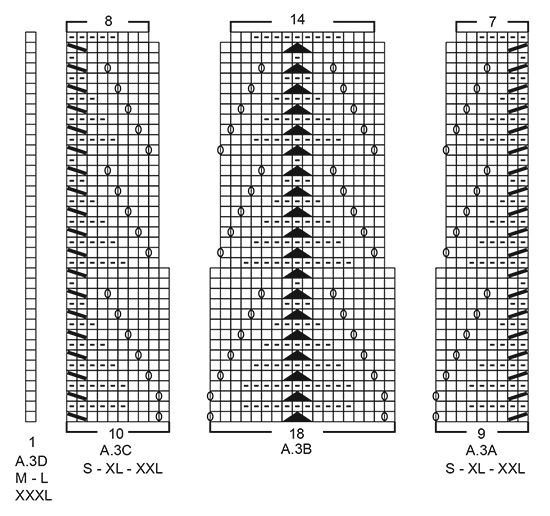
|
|||||||||||||||||||

|
|||||||||||||||||||
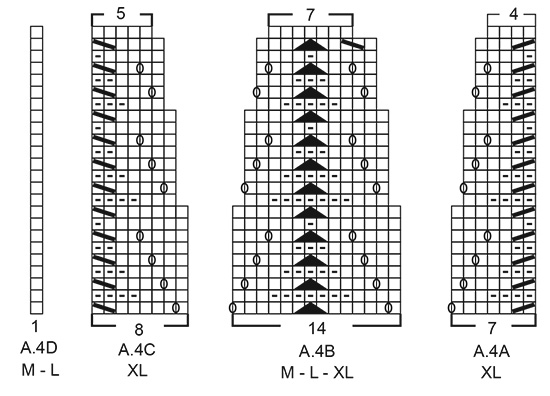
|
|||||||||||||||||||

|
|||||||||||||||||||
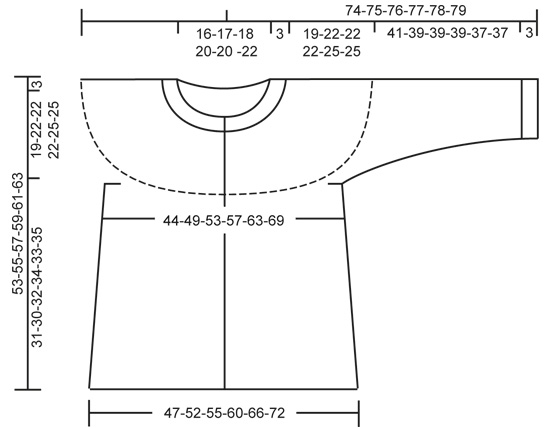
|
|||||||||||||||||||
|
Have you made this or any other of our designs? Tag your pictures in social media with #dropsdesign so we can see them! Do you need help with this pattern?You'll find tutorial videos, a Comments/Questions area and more by visiting the pattern on garnstudio.com. © 1982-2024 DROPS Design A/S. We reserve all rights. This document, including all its sub-sections, has copyrights. Read more about what you can do with our patterns at the bottom of each pattern on our site. |
|||||||||||||||||||







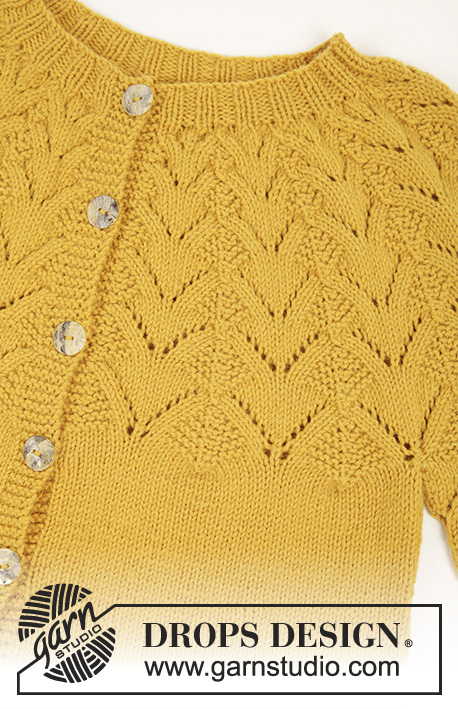


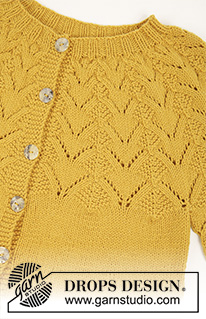
















































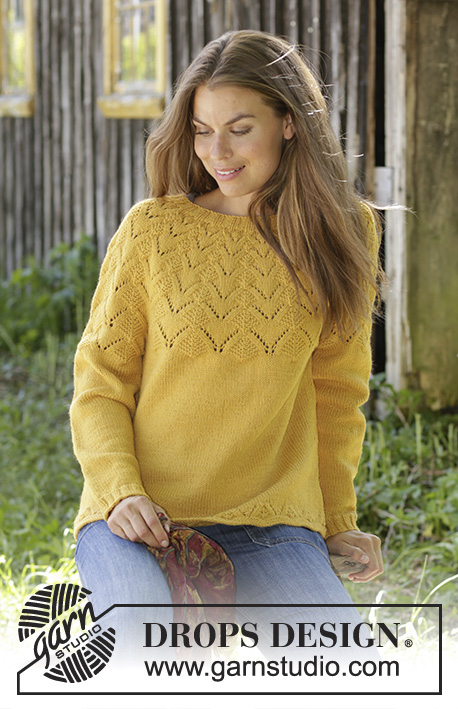






Comments / Questions (49)
Hello! I have a question: what can I do if the sleeves are too long for me? What should I do to reduce the length?
12.02.2020 - 11:06DROPS Design answered:
Dear Mrs Желтякова, you will have to make some adjustements such as calculating when increasing for ex as well as when starting to work diagram - please contact the store where you bought the yarn for any individual assistance. Happy knititng!
12.02.2020 - 11:24Strikker i str M og skal ta inn de først 4 maskene i boken, men da stemmer jo ikke mønstret lenger. Skal det kun strikkes rett ved merkene? Stemmer da kast nå to masker samme og flytting av maske ikke blir gjort? Føler meg litt dum nå faktisk.
01.01.2020 - 12:12DROPS Design answered:
Hei Turid. Når du skal ta inn de første 4 maskene er du ferdig med diagram A.1A og A.1B og det strikkes glattstrikk. mvh DROPS design
10.02.2020 - 08:48Hej. Jeg har strikke den gule trøje i størrelse M. Jeg har ikke haft problemer med mønsteret, men trøjen er for kort....... 30 cm plus 22 cm giver 52 cm. Hvor får i de sidste 6 cm fra. Halskanten gør ikke trøjen længere og 2 gange 3 det forstår jeg ikke. Vh Lone
22.11.2019 - 18:37DROPS Design answered:
Hej Lone. Jo halskanten vil gøren bærestykket længere. Men vi skal tjekke om de sidste 3 cm kommer med tyngden/mønsteret i blusen. :)
03.12.2019 - 13:51Jeg strikker den gule trøje med mønstret bærestykke (195/23). Når man kommer op til bærestykker, har sat ærmerne i og strikket det første mønsterstykke (15 pinde op), så skal der tages ind. Det fremgår af diagrammet (3), at der forsvinder 2 masker mellem hver mønsterrapport, men der står intet om, hvordan indtagningen skal foretages. Kan I hjælpe mig? Venlig hilsen Ulla
29.10.2019 - 22:41DROPS Design answered:
Hej Ulla, jo på pind 15 i A.3B tager du 2 masker ind i midten af diagrammet som du har gjort på hver 2.pind ifølge hele diagrammet MEN du tager ikke ud på pind 15, som du har gjort de andre gange. God fornøjelse!
31.10.2019 - 10:00Hei! Jeg er veldig redd for at garnmengden som oppgis i oppskriften blir for lite! Jeg strikker XXL, men har kjøpt 800 gram garn. Har nå strikket 13 cm på bolen og brukt 100 gram. Strikkefastheten min stemmer. Vil garnmengden garantert holde?
18.09.2019 - 20:22Jeg opplever samme problem som Mevik på mønster A2. Jeg strikker står XL, men når jeg kommer til omgang 4 stemmer ikke mønsteret. Hva er feil?
16.09.2019 - 14:19DROPS Design answered:
Hej Inger, du har samme antal masker igennem hele diagram A.2. Sæt gerne et lille mærke imellem hver overgang, så du er sikker på at du starter på det rigtige sted med første omslag i diagrammet. God fornøjelse1
17.09.2019 - 14:42Hej, Jeg er med på, hvordan man samler delene. Men der mangler diagram for, når man starter, inden man når til ærmegabet/ sammenstrikning af delene, så det passer i højde med ærmerne. VH mette
14.09.2019 - 22:07Hej, Det ser ud som om der er fejl i opskrift. Der mangler beskrivelse for, når man skal strikke delene sammen. DVS hulmønstret er ikke med på ryg og forstykke ?
29.08.2019 - 10:04DROPS Design answered:
Hej Mette, nede under BÆRESTYKKE sætter du delene sammen og fortsætter over alle masker på pinden. God fornøjelse!
06.09.2019 - 11:46Hei har problemer med og skjønne raport A2 til ermene.Omg.4 får jeg ikke til og stemme uansett hva jeg gjør.Det er 18 masker i hver raport ,når jeg begynner på omg 4 ,først 3 masker rettstrikk,som er i start og slutt i hver omg.5 rette og 9 vrange,når jeg har strikket 5 rette,kommer jeg rett over omg.2 med vrangmasker,skal være en etter,får ikke dette til og stemme.Trenger hjelp her.
19.08.2019 - 14:51DROPS Design answered:
Hei Reidun. Vi skal prøve å hjelpe deg så fort som mulig, men hvilken størrelse strikker du?
20.08.2019 - 13:09Désolée de vous avoir importuné!!!!! je me suis trompé dans les calculs!!!!oubliez mon commentaire; J Cambos.
03.06.2019 - 14:43